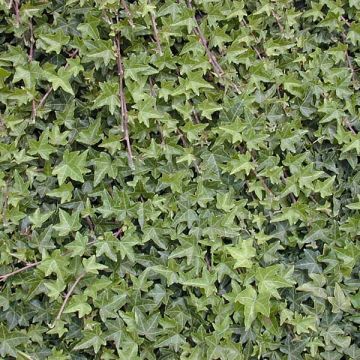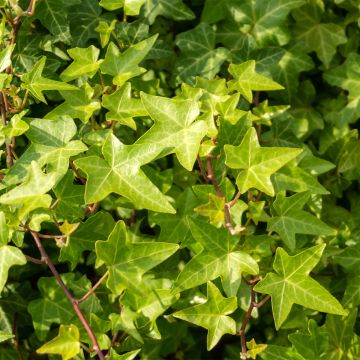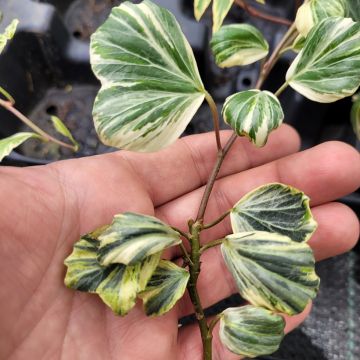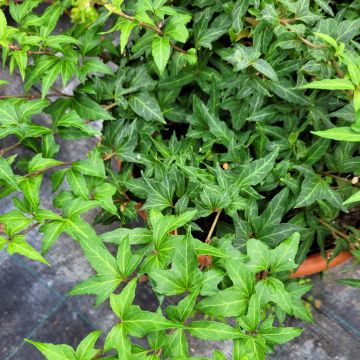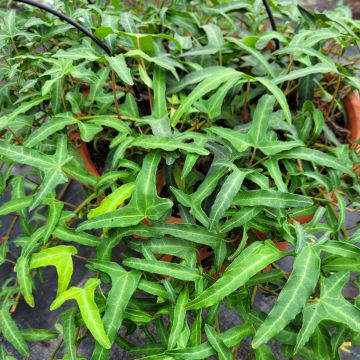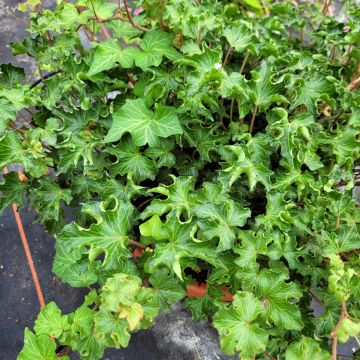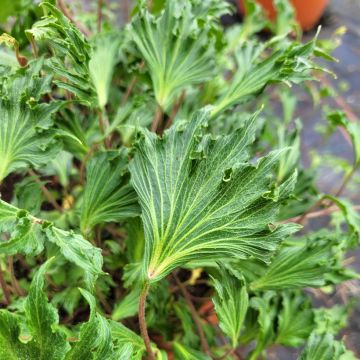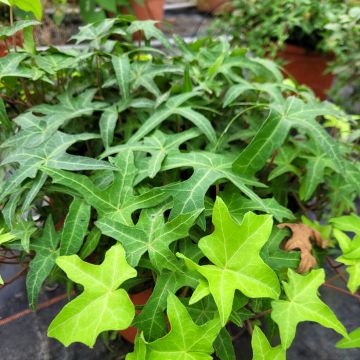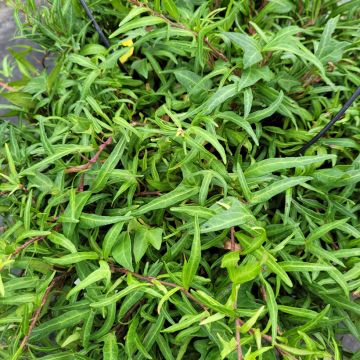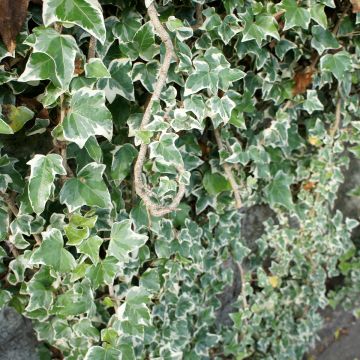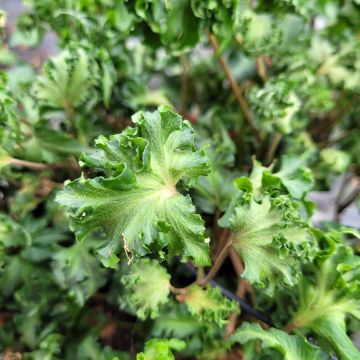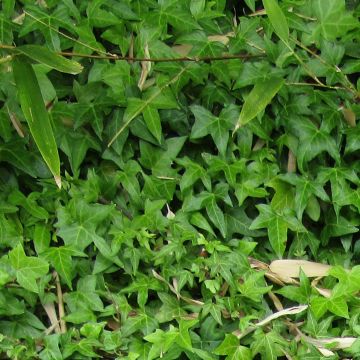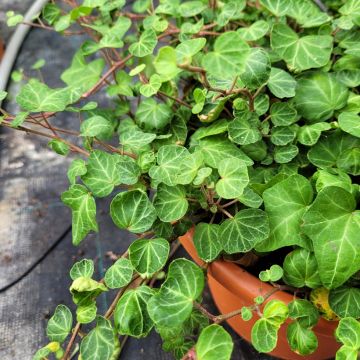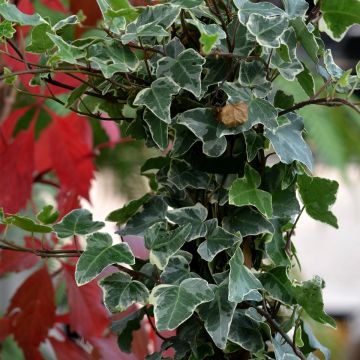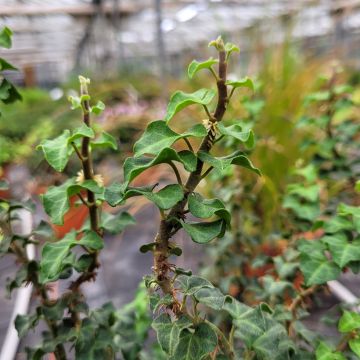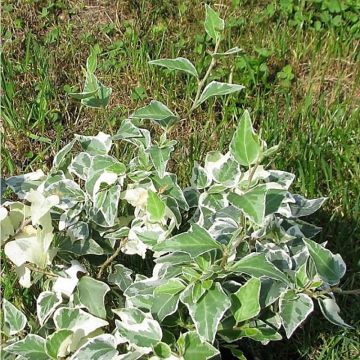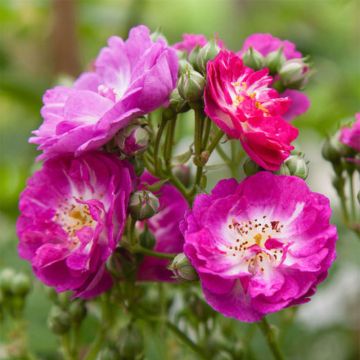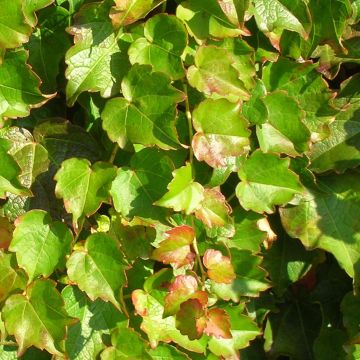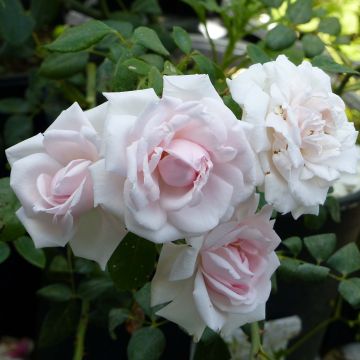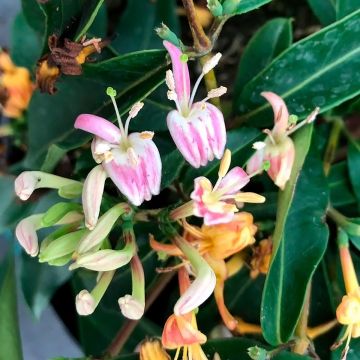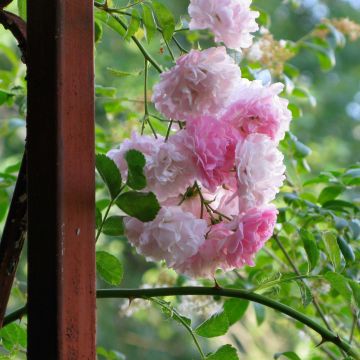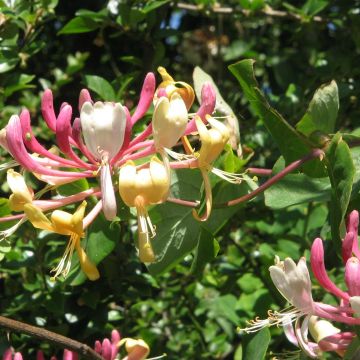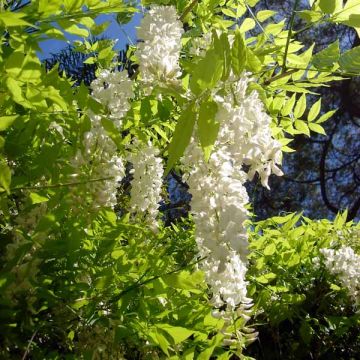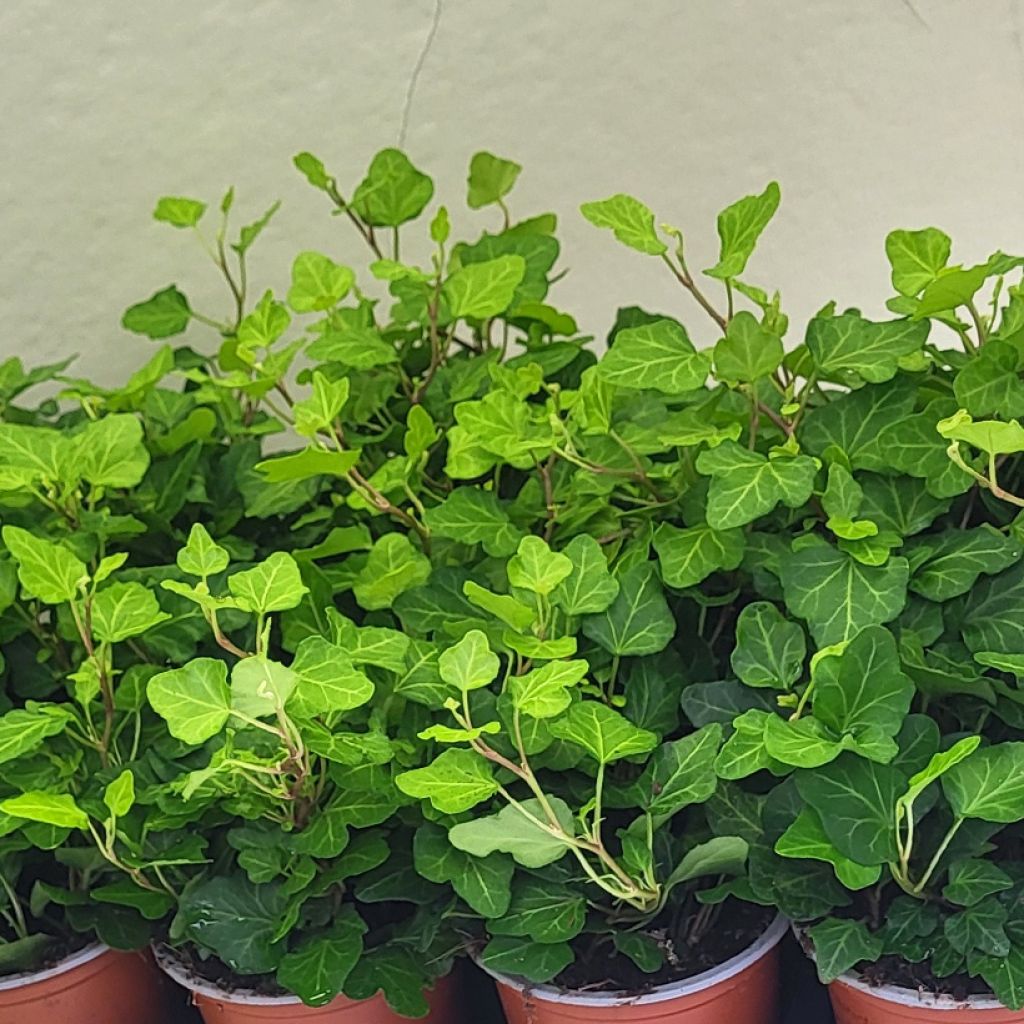

Hedera helix Wonder - Common ivy
Hedera helix Wonder - Common ivy
Hedera helix Wonder
English ivy, Common ivy, European ivy
Why not try an alternative variety in stock?
View all →This plant carries a 6 months recovery warranty
More information
We guarantee the quality of our plants for a full growing cycle, and will replace at our expense any plant that fails to recover under normal climatic and planting conditions.
From €5.90 for pickup delivery and €6.90 for home delivery
Express home delivery from €8.90.
Does this plant fit my garden?
Set up your Plantfit profile →
Description
Hedera helix 'Wonder' is a selection of common ivy appreciated for its attractive foliage and versatility. This evergreen climbing plant is characterised by its thick and leathery leaves, green with silvery highlights and rather compact growth. This makes it a good choice for hanging baskets and walls. Its ability to purify the air and create a soothing natural atmosphere is valued for interior decoration. It is also a hardy and undemanding plant, interesting for greening slightly shaded areas of the terrace or garden.
Ivies belong to the Araliaceae family. The Hedera genus includes about a dozen species, the most common in our latitudes being the Common Ivy, in Latin Hedera helix. This giant of our forests can reach lengths of tens of metres and climb to the tops of surrounding trees.
Hedera helix 'Wonder' is a variety with a much more modest growth whose stems will not exceed 4 m in height. Its small leaves are wide and rounded, with 3 coarsely toothed lobes with very distinct light veins. They are a fairly dark green, shiny, and have a silvery sheen. They are evergreen, so decorative all year round. The stems cling to supports on their own with strong climbing roots. In late summer or autumn, its greenish flowering, in the form of globular inflorescences, is an excellent nectar source for bees. This is followed by the formation of black berries, toxic to humans but an excellent winter food source for birds.
Hedera helix 'Wonder' is perfect for adding a touch of greenery to your interior, especially when used in hanging planters. This plant is also ideal for creating an elegant and natural ambience in the garden or on the terrace. Ivy pairs particularly well with ferns (such as Nephrolepis 'Artic Jungle'), Philodendron scandens, Pothos (Epipremnum aureum), and Chlorophytum comosum. These plants, like Hedera helix 'Wonder', thrive in shaded environments and together can create a lush and harmonious display. In the garden, pair it with easy-care woodland perennials like Epimedium, Lungworts, or Hellebores.
Report an error about the product description
Plant habit
Flowering
Foliage
Safety measures
Botanical data
Hedera
helix
Wonder
Araliaceae
English ivy, Common ivy, European ivy
Cultivar or hybrid
ingestion
Cette plante est toxique si elle est ingérée volontairement ou involontairement.
Ne la plantez pas là où de jeunes enfants peuvent évoluer, et lavez-vous les mains après l'avoir manipulée.
Pensez à conserver l'étiquette de la plante, à la photographier ou à noter son nom, afin de faciliter le travail des professionnels de santé.
Davantage d'informations sur https://plantes-risque.info
Other Hedera - Ivy
Planting and care
Hedera helix 'Wonder', easy to grow in any regular soil, can be planted all year round. It prefers fertile, moist, well-drained soil, but is very accommodating (regarding the presence of limestone or clay if the soil is well worked) and quite resistant to drought once established. Ideally, plant it against a wall, in a semi-shaded position sheltered from cold winds to help it settle, and monitor watering during the first 2 years after planting, especially in dry summers. To promote young shoots more quickly, fix the first ones to the ground (layering). You can rejuvenate the base by removing old branches. Prune regularly to shape it. Remove any branches that bear non-variegated leaves or those that take on an upright and bushy form.
For container cultivation, mix 7 parts regular soil, 3 parts peat, and 2 parts sand. Water regularly and apply fertiliser every month during the growing season. Keep the substrate moist during winter.
Planting period
Intended location
Care
This item has not been reviewed yet - be the first to leave a review about it.
Foolproof climbers
Haven't found what you were looking for?
Hardiness is the lowest winter temperature a plant can endure without suffering serious damage or even dying. However, hardiness is affected by location (a sheltered area, such as a patio), protection (winter cover) and soil type (hardiness is improved by well-drained soil).

Photo Sharing Terms & Conditions
In order to encourage gardeners to interact and share their experiences, Promesse de fleurs offers various media enabling content to be uploaded onto its Site - in particular via the ‘Photo sharing’ module.
The User agrees to refrain from:
- Posting any content that is illegal, prejudicial, insulting, racist, inciteful to hatred, revisionist, contrary to public decency, that infringes on privacy or on the privacy rights of third parties, in particular the publicity rights of persons and goods, intellectual property rights, or the right to privacy.
- Submitting content on behalf of a third party;
- Impersonate the identity of a third party and/or publish any personal information about a third party;
In general, the User undertakes to refrain from any unethical behaviour.
All Content (in particular text, comments, files, images, photos, videos, creative works, etc.), which may be subject to property or intellectual property rights, image or other private rights, shall remain the property of the User, subject to the limited rights granted by the terms of the licence granted by Promesse de fleurs as stated below. Users are at liberty to publish or not to publish such Content on the Site, notably via the ‘Photo Sharing’ facility, and accept that this Content shall be made public and freely accessible, notably on the Internet.
Users further acknowledge, undertake to have ,and guarantee that they hold all necessary rights and permissions to publish such material on the Site, in particular with regard to the legislation in force pertaining to any privacy, property, intellectual property, image, or contractual rights, or rights of any other nature. By publishing such Content on the Site, Users acknowledge accepting full liability as publishers of the Content within the meaning of the law, and grant Promesse de fleurs, free of charge, an inclusive, worldwide licence for the said Content for the entire duration of its publication, including all reproduction, representation, up/downloading, displaying, performing, transmission, and storage rights.
Users also grant permission for their name to be linked to the Content and accept that this link may not always be made available.
By engaging in posting material, Users consent to their Content becoming automatically accessible on the Internet, in particular on other sites and/or blogs and/or web pages of the Promesse de fleurs site, including in particular social pages and the Promesse de fleurs catalogue.
Users may secure the removal of entrusted content free of charge by issuing a simple request via our contact form.
The flowering period indicated on our website applies to countries and regions located in USDA zone 8 (France, the United Kingdom, Ireland, the Netherlands, etc.)
It will vary according to where you live:
- In zones 9 to 10 (Italy, Spain, Greece, etc.), flowering will occur about 2 to 4 weeks earlier.
- In zones 6 to 7 (Germany, Poland, Slovenia, and lower mountainous regions), flowering will be delayed by 2 to 3 weeks.
- In zone 5 (Central Europe, Scandinavia), blooming will be delayed by 3 to 5 weeks.
In temperate climates, pruning of spring-flowering shrubs (forsythia, spireas, etc.) should be done just after flowering.
Pruning of summer-flowering shrubs (Indian Lilac, Perovskia, etc.) can be done in winter or spring.
In cold regions as well as with frost-sensitive plants, avoid pruning too early when severe frosts may still occur.
The planting period indicated on our website applies to countries and regions located in USDA zone 8 (France, United Kingdom, Ireland, Netherlands).
It will vary according to where you live:
- In Mediterranean zones (Marseille, Madrid, Milan, etc.), autumn and winter are the best planting periods.
- In continental zones (Strasbourg, Munich, Vienna, etc.), delay planting by 2 to 3 weeks in spring and bring it forward by 2 to 4 weeks in autumn.
- In mountainous regions (the Alps, Pyrenees, Carpathians, etc.), it is best to plant in late spring (May-June) or late summer (August-September).
The harvesting period indicated on our website applies to countries and regions in USDA zone 8 (France, England, Ireland, the Netherlands).
In colder areas (Scandinavia, Poland, Austria...) fruit and vegetable harvests are likely to be delayed by 3-4 weeks.
In warmer areas (Italy, Spain, Greece, etc.), harvesting will probably take place earlier, depending on weather conditions.
The sowing periods indicated on our website apply to countries and regions within USDA Zone 8 (France, UK, Ireland, Netherlands).
In colder areas (Scandinavia, Poland, Austria...), delay any outdoor sowing by 3-4 weeks, or sow under glass.
In warmer climes (Italy, Spain, Greece, etc.), bring outdoor sowing forward by a few weeks.

































